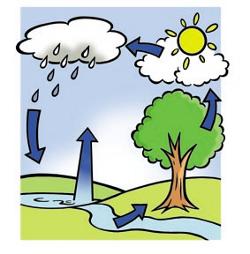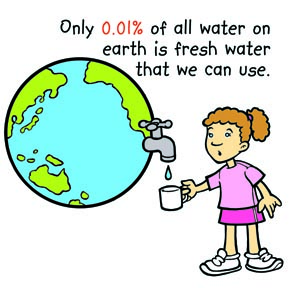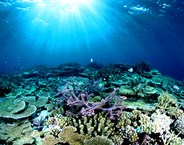Diary Chapters
Wonderful water
Wise Words
Only 0.01% of all water on earth is fresh water that we can use. We better learn to use what we have wisely.

THE WATER CYCLE
The fresh water we use each day from local reservoirs or rainwater
tanks is actually as old as the hills - maybe even older! Water
makes its way around the planet in a process known as the
water cycle. When it's hot, liquid water in the oceans turns
into gas that rises into the atmosphere through the process of
evaporation. High in the sky, the gas cools down and turns into
little droplets, forming clouds. When the little droplets get
denser, they form bigger droplets of liquid water. When the
droplets get too heavy, they fall back down to Earth as rain. When
it's really cold, the water will turn solid and form snow or
hail.
You can watch a funny video about the water cycle here!

COME RAIN, COME SHINE
When it rains, it pours - so true for Australia, the second driest
continent on Earth after Antarctica. After a decade of drought, we
were devastated by floods in 2011 and 2012! There's not much that
we can do to change the cycle of floods and droughts, but we can
take better care of our catchments and teach families how to
prepare better. Find out more about what catchments are here!
2013: International
Year of Water Cooperation
780 million people do not have clean water and even more do not
have clean toilets to use. Most of the planet's population lives in
the driest areas. Water is incredibly precious and some countries
share rivers which supply water to their citizens.
Become a Reef Guardian
Ask your teacher to sign
up your class as Reef Guardians so that you can find out
more about protecting the Great Barrier Reef. You can find out more
about the reef by watching this video!

There is more fresh water stored underground in aquifers than in
lakes and rivers on the Earth's surface.
About 70% of our bodies are made up of water.
Angus McMahon, Albuera St Primary, TAS
Angus goes the extra mile for the planet. Passionate
about sustainability, he has helped teach students and teachers
about growing a community garden and saving energy. He is a
consistent role model for others keeping the compost and recycling
systems working. Angus walks the talk!
What's your water footprint? Make a list of all the different
ways you use water each day and go online to calculate your
water footprint.
Ban plastic bottles in your family and make sure everyone uses
their own reusable water bottles. Make posters for school
explaining why this is important.
CARING FOR OUR CATCHMENTS
A catchment is like a giant bucket, waiting to catch rain and
the water that flows down the mountains, through the valleys, along
creeks and into our rivers and oceans.
The Murray Darling Basin is Australia's biggest catchment. It's
actually one of the largest river systems in the world, covering
almost 1 million square kilometres across five Australian states
and territories, connecting 23 different rivers and providing the
water to produce more than one third of Australia's food supply.
The basin is so important that the government has set up a
special authority to manage it. Lear more about the Murray Darling
Basin Authority here!
The Murray Darling Basin is home to a rich variety of biodiversity
including birds, fish, insects, plants and marsupials.

THREATS TO THE MURRAY DARLING BASIN
- When we are in drought, there is less water for people, animals
and plants
- People and nature at the bottom of the river suffer most
because much of the water is used for agriculture, industries and
towns further up the river
- When we have lots of rain, communities near the river can
suffer from floods and farmers can lose their crops
- Farming makes the natural water table rise and bring with it
lots of salt previously stored deep in the ground
WHAT CAN WE DO?
We can raise awareness about the problem of salinity, especially
in the Murray Darling Basin so that more people understand the
seriousness of the issue. Learn more about it here!
Stuff to Check Out
AHOY - ACID OCEANS AHEAD
Carbon dioxide emissions absorbed by
the world's
oceans are also making them more acidic than
they have been for tens of millions of years!
Learn more here.
 CATCH EVERY
DROP
CATCH EVERY
DROP
We need to be careful not to waste a single drop! Help your
parents choose and install a rainwater tank, turn off the tap when
you're not using it and half-flush the loo when possible.
Learn how to use less water on the
'Water Use It Wisely' website.
PUREOLOGY
Green Cross supporters and hair care brand Pureology is
dedicated to water conservation. To help reduce water waste in the
hairdressing industry, they've launched the WaterSaver Salon website. This clever
website allows salons to measure their current water use and
identify simple ways to reduce their water waste. Brilliant!
THE GREAT PACIFIC GARBAGE PATCH
Way out in the Pacific Ocean, there is a HUGE pile of floating
garbage known as the 'Pacific Trash Vortex' or the 'Great Pacific
Garbage Patch'. The total size is unclear, as it accumulates in 5
different gyres or ocean currents that are constantly moving. Some
people think it's the same size as France!
This stretch of ocean is covered with millions of bits of
plastic mixed with chemical sludge and all sorts of rubbish
that has fallen off a boat or found its way down our catchments
and into the oceans. Unlike other materials, plastic
takes more than 1000 years to break down. It disintegrates into
plastic confetti that fish can swallow and, if we eat the fish, we
swallow it too!
You can watch a video about the damage the pacific garbage is
doing here!
CORAL BLEACHING
The Great Barrier Reef stretches along the east coast of Australia
for almost 2000km and is home to many colourful and amazing sea
creatures such as corals. Corals are highly sensitive organisms and
need perfect conditions to survive. Corals LOVE pure, salty water,
the right temperature and lots of marine friends.
Scientists have discovered that higher temperatures and carbon
dioxide emissions are bleaching coral, leaving it white and
lifeless. Turtles, fish, seabirds, starfish and anemones who depend
on healthy coral for their survival are also being threatened by
the problem of coral bleaching.
You can learn more about coral bleaching on the ReefEd website! Just like in the
reef, there is lots to explore...
